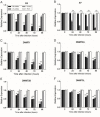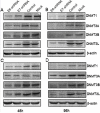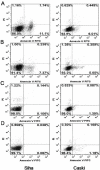E6 and E7 gene silencing results in decreased methylation of tumor suppressor genes and induces phenotype transformation of human cervical carcinoma cell lines
- PMID: 26329329
- PMCID: PMC4695162
- DOI: 10.18632/oncotarget.4525
E6 and E7 gene silencing results in decreased methylation of tumor suppressor genes and induces phenotype transformation of human cervical carcinoma cell lines
Abstract
In SiHa and CaSki cells, E6 and E7-targeting shRNA specifically and effectively knocked down human papillomavirus (HPV) 16 E6 and E7 at the transcriptional level, reduced the E6 and E7 mRNA levels by more than 80% compared with control cells that expressed a scrambled-sequence shRNA. E6 and E7 repression resulted in down-regulation of DNA methyltransferase mRNA and protein expression, decreased DNA methylation and increased mRNA expression levels of tumor suppressor genes, induced a certain apoptosis and inhibited proliferation in E6 and E7 shRNA-infected SiHa and CaSki cells compared with the uninfected cells. Repression of E6 and E7 oncogenes resulted in restoration of DNA methyltransferase suppressor pathways and induced apoptosis in HPV16-positive cervical carcinoma cell lines. Our findings suggest that the potential carcinogenic mechanism of HPV16 through influencing DNA methylation pathway to activate the development of cervical cancer exist, and maybe as a candidate therapeutic strategy for cervical and other HPV-associated cancers.
Keywords: DNA methylation; HPV16 E6 and E7; cell viability and apoptosis; human cervical carcinoma cell lines; immunoblot.
Conflict of interest statement
Authors declare that they have no conflict of interest.
Figures









Similar articles
-
Inhibition of cervical cancer cell growth in vitro and in vivo by lentiviral-vector mediated shRNA targeting the common promoter of HPV16 E6 and E7 oncogenes.Antiviral Res. 2013 May;98(2):305-13. doi: 10.1016/j.antiviral.2013.03.010. Epub 2013 Mar 21. Antiviral Res. 2013. PMID: 23523766
-
E6 and e7 gene silencing and transformed phenotype of human papillomavirus 16-positive oropharyngeal cancer cells.J Natl Cancer Inst. 2009 Mar 18;101(6):412-23. doi: 10.1093/jnci/djp017. Epub 2009 Mar 10. J Natl Cancer Inst. 2009. PMID: 19276448
-
HPV16 oncogenes E6 or/and E7 may influence the methylation status of RASSFIA gene promoter region in cervical cancer cell line HT-3.Oncol Rep. 2017 Apr;37(4):2324-2334. doi: 10.3892/or.2017.5465. Epub 2017 Feb 17. Oncol Rep. 2017. PMID: 28260046
-
High-Risk Human Papillomavirus Oncogenic E6/E7 mRNAs Splicing Regulation.Front Cell Infect Microbiol. 2022 Jun 27;12:929666. doi: 10.3389/fcimb.2022.929666. eCollection 2022. Front Cell Infect Microbiol. 2022. PMID: 35832386 Free PMC article. Review.
-
HPV E6/E7: insights into their regulatory role and mechanism in signaling pathways in HPV-associated tumor.Cancer Gene Ther. 2024 Jan;31(1):9-17. doi: 10.1038/s41417-023-00682-3. Epub 2023 Dec 15. Cancer Gene Ther. 2024. PMID: 38102462 Review.
Cited by
-
Molecular events leading to HPV-induced high grade neoplasia.Papillomavirus Res. 2016 Dec;2:85-88. doi: 10.1016/j.pvr.2016.04.003. Epub 2016 Apr 12. Papillomavirus Res. 2016. PMID: 29074190 Free PMC article. Review.
-
Prevalence and Genotyping of HPV in Oral Squamous Cell Carcinoma in Northern Brazil.Pathogens. 2022 Sep 27;11(10):1106. doi: 10.3390/pathogens11101106. Pathogens. 2022. PMID: 36297163 Free PMC article.
-
Biomarkers in Tumorigenesis Using Cancer Cell Lines: A Systematic Review.Asian Pac J Cancer Prev. 2017 Sep 27;18(9):2329-2337. doi: 10.22034/APJCP.2017.18.9.2329. Asian Pac J Cancer Prev. 2017. PMID: 28950674 Free PMC article.
-
Host-cell DNA methylation patterns during high-risk HPV-induced carcinogenesis reveal a heterogeneous nature of cervical pre-cancer.Epigenetics. 2018;13(7):769-778. doi: 10.1080/15592294.2018.1507197. Epub 2018 Aug 24. Epigenetics. 2018. PMID: 30079796 Free PMC article.
-
The precision prevention and therapy of HPV-related cervical cancer: new concepts and clinical implications.Cancer Med. 2018 Oct;7(10):5217-5236. doi: 10.1002/cam4.1501. Epub 2018 Sep 14. Cancer Med. 2018. PMID: 30589505 Free PMC article. Review.
References
-
- Torre L.A, et al. Global cancer statistics, 2012. CA Cancer J Clin. 2015;65:87–108. - PubMed
-
- Parkin D.M, et al. Global cancer statistics, 2002. CA Cancer J Clin. 2005;55:74–108. - PubMed
-
- Zhou J, et al. Inhibition of cervical cancer cell growth in vitro and in vivo by lentiviral-vector mediated shRNA targeting the common promoter of HPV16 E6 and E7 oncogenes. Antiviral Research. 2013;98:305–313. - PubMed
-
- Rampias T, et al. E6 and E7 Gene Silencing and Transformed Phenotype of Human Papillomavirus 16-Positive Oropharyngeal Cancer Cells. JNCI Journal of the National Cancer Institute. 2009;101:412–423. - PubMed
-
- Zhou J, et al. Transcriptional gene silencing of HPV16 E6/E7 induces growth inhibition via apoptosis in vitro and in vivo. Gynecologic Oncology. 2012;124:296–302. - PubMed
Publication types
MeSH terms
Substances
LinkOut - more resources
Full Text Sources
Other Literature Sources
Medical

